15 brown birds In Florida
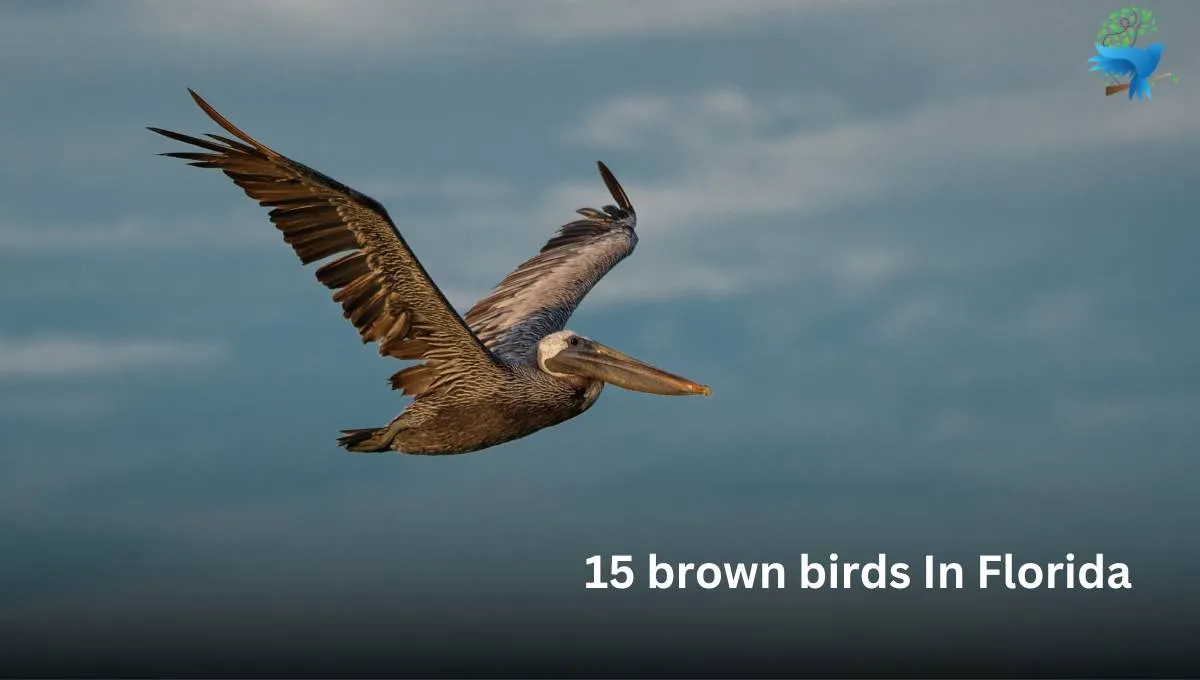
Florida’s different ecosystems, which range from pristine beaches to broad marshlands, make it a birder’s paradise.
Brown birds stand out for their hidden yet compelling presence among this state’s many avian species.
Brown-hued birds, such as the Brown Thrasher and the small Carolina Wren, beautify Florida’s skies, woodlands, and wetlands with their distinct traits and behaviors.
In this article, we will delve into the world of brown birds in Florida, discovering their exciting characteristics, habitats, and critical roles in the state’s rich biodiversity.
Join us on a journey to uncover the captivating appeal and significance of Florida’s often-overlooked yet vital brown bird population.
List of 15 Brown Birds In Florida
- Brown Thrasher (Toxostoma rufum)
- Swamp Sparrow (Melospiza georgiana)
- Brown-Headed Cowbird (Molothrus ater)
- Marsh Wren (Cistothorus palustris)
- Wood Thrush (Hylocichla mustelina)
- Brown Pelican (Pelecanus Occidentalis)
- Carolina Wren (Thryothorus ludovicianus)
- Northern Waterthrush (Parkesia Noveboracensis)
- White-throated sparrow (Zonotrichia Albicollis)
- Grasshopper Sparrows (Ammodramus savannarum)
- House Wren (Troglodytes aedon)
- Hermit Thrush (Catharus guttatus)
- Brown-headed Nuthatch (Sitta pusilla)
- Willet (Tringa semipalmata)
- Swainson’s Thrush (Catharus ustulatus)
1. Brown Thrasher (Toxostoma rufum)
The Brown Thrasher is often known as the brown thrush or the fox-coloured thrush. It belongs to the Mimidae family, which includes mockingbirds and New World catbirds.
They are foxy brown birds with thick, dark striping on their pale underparts. The Brown Thrasher face is gray-brown, and the wings include two black-and-white wing bars. They have brilliant yellow eyes.
The maximum known lifetime of Brown Thrasher in the wild is twelve years, whereas, in captivity, it ranges from ten to twelve.
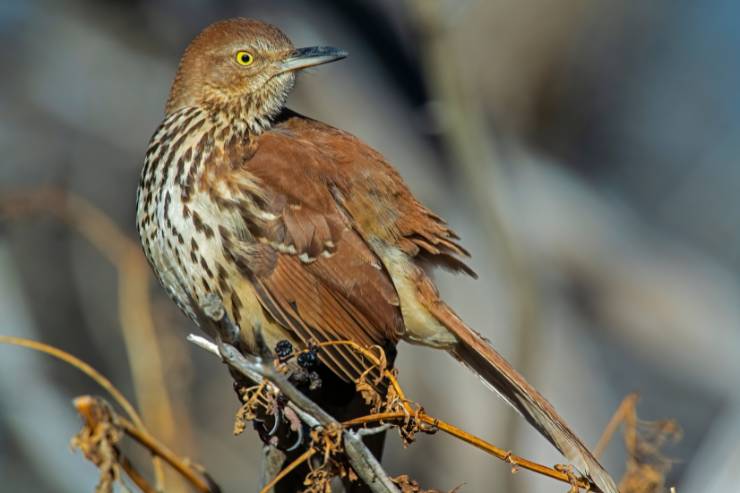
Size and wingspan of Brown Thrasher:
- Length: 23.5 to 30.5 centimeters (9.3 to 12.0 inches)
- Wingspan: 29 to 33 centimeters (11 to 13 inches)
- Weight: 61 to 89 grams (2.2 to 3.1 oz)
Brown thrashers spread from southeastern Canada to the eastern, central, and southeastern United States. They are the only thrashers found east of the Rocky Mountains and central Texas.
The brown thrasher lives in dense forests, shrubs, brushes, and thorn scrub. These species can be found in dense low-growth habitats, particularly around the edges of deciduous, shrubby swamp edges or undergrowth in open pine woods and suburban neighborhoods.
Brown Thrashers eat insects, nuts, and fruits. More than half of their meals are insects, including caterpillars, beetles, cicadas, grasshoppers, and bugs.
2. Swamp Sparrow (Melospiza georgiana)
The swamp sparrow is a medium-sized sparrow similar to the song sparrow. Its upper parts are dark red-brown, and the wings and shoulders have black streaks and reddish patches.
The head of swamp sparrows is dark gray, with a chestnut crown (brown and black streaks and a gray central stripe). It has an average lifespan of nearly six years.
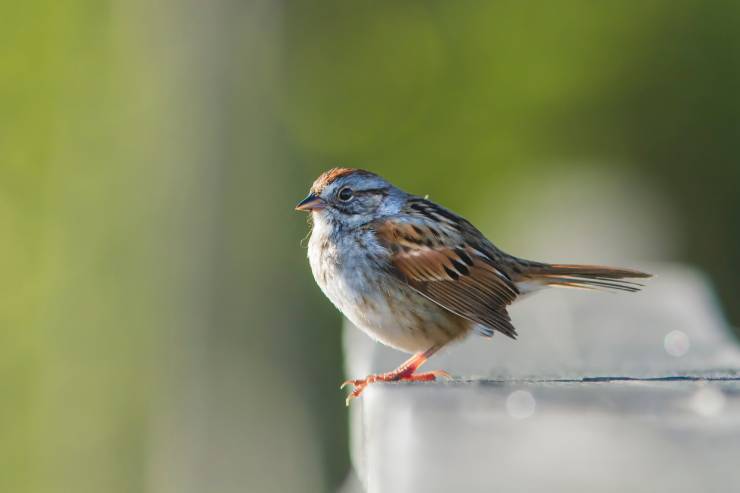
Size and wingspan of Swamp Sparrow:
- Length: 12–15 centimeters (4.7-5.9 inches)
- Wingspan: 18–19 centimeters (7.1-7.5 inches)
- Weight: 15–23 grams (0.5-0.8 oz)
They are present in the northern United States and boreal Canada. Look for wetlands with tall reeds, sedges, or similar plants to find Swamp Sparrows.
They devour insects such as bees, beetles, ants, wasps, aphids, grasshoppers, caterpillars, crickets, and aquatic invertebrates, including molting damselflies and dragonflies.
They also eat blueberries, swamp dock, smartweed, and vervains.
Read More: 15 red birds of Florida (With Pictures)
3. Brown-Headed Cowbird (Molothrus ater)
Brown-headed Cowbirds are little blackbirds with shorter tails and thicker heads than most.
Their beak is peculiar: it is much shorter and thicker-based than that of other blackbirds.
Male Brown-Headed Cowbirds have glossy black feathers and a deep brown head that appears black in low lighting or from a distance.
Female Brown-Headed Cowbirds are basic brown birds with a light head and underparts, fine streaking on the belly, and a dark eye.
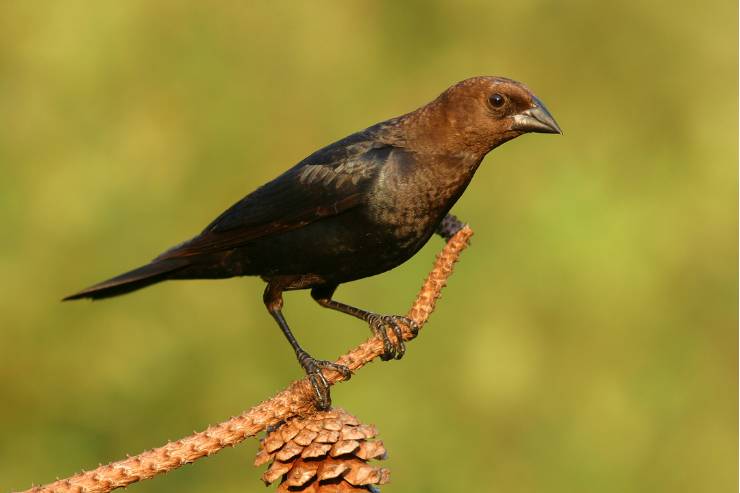
Size and wingspan of Brown-Headed Cowbird:
- Length: 16–22 centimeters (6.3–8.7 inches)
- Wingspan: 36 centimeters (14 inches)
- Weight of male: 49 grams (1.7 oz)
- Weight of female: 38.8 grams (1.37 oz)
These species live in fields, meadows, and lawns. During the winter and migration, they can be found in mixed-species blackbird flocks.
Males have glossy black plumage and a faint brown head, while females have a short, thick bill and unmarked brown.
These birds mostly consume seeds and insects. It consumes seeds, including those from grasses, weeds, and waste grain, which make up for over half of its diet in the summer and more than 90% in winter.
Their diet consists primarily of insects, particularly caterpillars, beetles, and grasshoppers, and also includes spiders and millipedes.
4. Marsh Wren (Cistothorus palustris)
The marsh wren is a tiny North American songbird from the wren family. It is frequently referred to as the long-billed marsh wren to distinguish it from the short-billed marsh wren.
This species is round-bodied with a short tail. The Marsh Wren is rusty brown on top, with black and white streaks down the back. Its undersides are lighter.
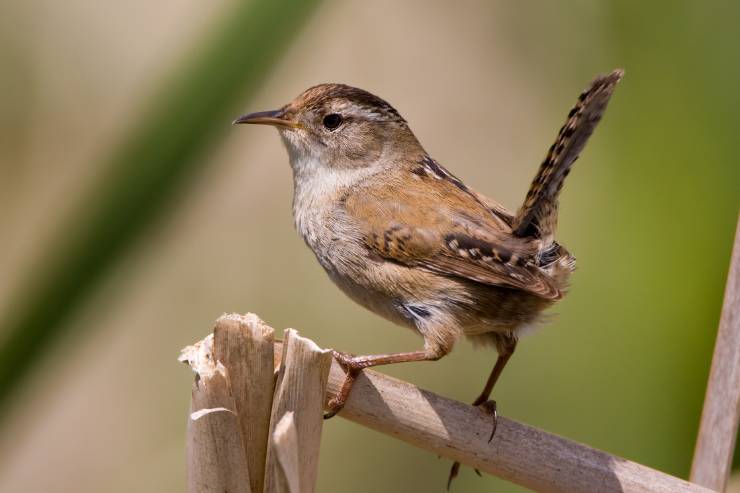
Size and Wingspan of Marsh Wren:
- Length: 10–14 centimeters (3.9-5.5 inches)
- Wingspan: 15 centimeters (5.9 inches)
- Weight: 9–14 grams (0.3-0.5 oz)
The marsh wren species can be found in Florida. Throughout the year, Marsh Wrens live in wetlands containing cattails, sedges, Pharagmites, bulrushes, and cord grass-filled saltmarshes.
In winter, they hide in brushy thickets near wetlands, and weedy agricultural trenches.
5. Wood Thrush (Hylocichla mustelina)
The Wood Thrush belongs to the Turdidae family and is the sole species in the Hylocichla genus.
They are closely related to other thrushes, such as the American robin. Wood Thrushes are warm reddish-brown on top and white on the underside, with striking black dots. Kids have a more muted version of the same pattern.
The oldest known bird lived for eight years; however, wood thrushes are likely to live for 1-2 years.
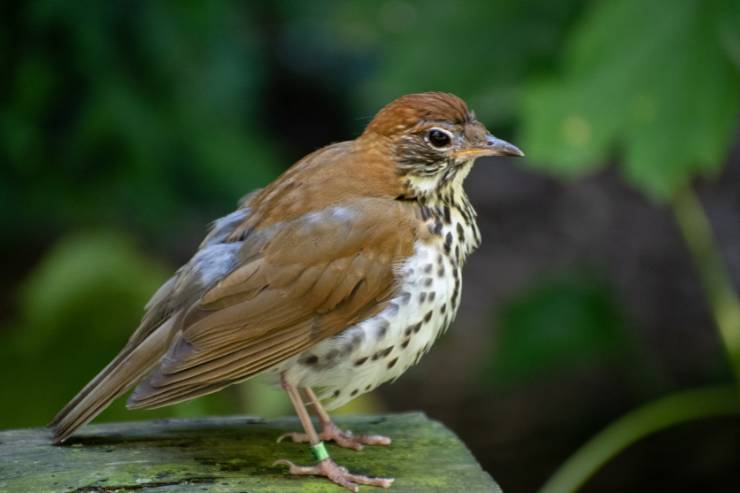
Size and Wingspan of Wood Thrush:
- Length: 19–21 centimeters (8.26-7.4 inches)
- Wingspan: 30–40 centimeters, 11.81-15.74
- Weight: 40–50 grams (1.41-1.76 oz)
The wood thrush can be found in northern Florida from late March to late October and breeds from May to July.
This bird prefers to reside in deep woodlands, which are its favored habitat.
Although it may breed in practically any woodland, it has the highest survival and reproduction rates in more extensive forests.
The wood thrush eats various insects, particularly during the breeding season, such as moths, snails, beetles, ants, spiders, ants, caterpillars, crickets, and earthworms. It also eats berries.
6. Brown Pelican (Pelecanus Occidentalis)
Brown pelicans are large, slender seabirds. These birds have narrow necks, long bills, and a stretchy throat bag for catching fish.
Their wings are extraordinarily long and wide and frequently bent while the birds glide. Adult brown pelicans are gray-brown birds with yellow heads and white necks.
Kids are gray-brown on top, including the head and neck, and have a pale yellowish belly and breast. Brown pelicans can live to be 40 years old.
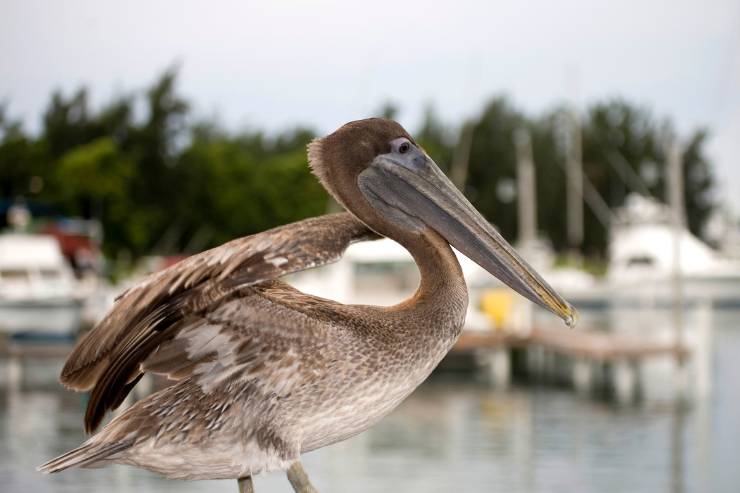
| Fact: A pelican’s throat pouch can contain more than two gallons of water. |
Size and wingspan of Brown Pelican:
- Length: 100–137 centimeters (39.4-53.9 inches)
- Wingspan: 198.1 centimeters (78 inches)
- Weight: 2000-5000 grams (70.5-176.4 oz)
Brown pelicans occupy beaches, docks, estuaries, mangrove islands, dredge spoil islands, sandbars, sand spits, and islets. They eat medium-sized fish and crabs.
Menhaden, top minnows, pigfish, sheepshead mullet, grass minnows, herring, and silversides are the most common foods they consume.
7. Carolina Wren(Thryothorus ludovicianus)
Carolina wrens are a common species in the wren family. They are tiny but sturdy birds with round bodies and long tails.
Their head is big, with a short neck, and the bill is long and slender. Both males and females are vibrant reddish brown above and warm caramel orange below, with no patterning.
The Carolina wren has an average lifespan of six years in the wild.
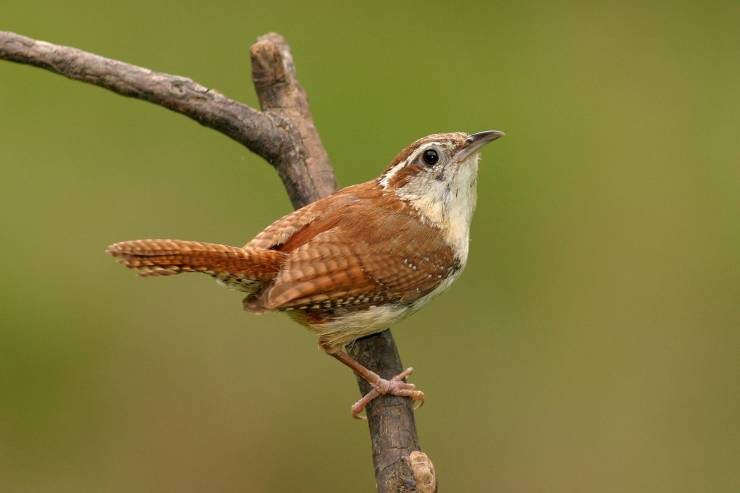
Size and wingspan of Carolina Wren:
- Length: 12–14 centimeters (4.7-5.5 inches)
- Wingspan: 29 centimeters (11.4 inches)
- Weight: 18–22 grams (0.6-0.8 oz)
Carolina wren populations have expanded and have become common throughout Florida. It lives in various habitats, including urban and suburban regions.
They favor moist areas with many plants and brush, although they also live in marshes, farm yards, and gardens.
Carolina wrens are primarily insectivores, feeding near or on the ground. They consume spiders, bugs, snails, beetles, crickets, bees, ants, and grasshoppers.
They will also check backyard bird feeders like platform and suet feeders.
8. Northern Waterthrush (Parkesia Noveboracensis)
The northern waterthrush is a migratory New World warbler from the Parkesia genus that feeds on the ground. It is dark brown above and whitish to pale yellowish below, with dark streaks on the breast.
The oldest Northern Waterthrush recorded was at least eight years and 11 months old when it was recovered and re-released during banding operations in Michigan in the year 1987.
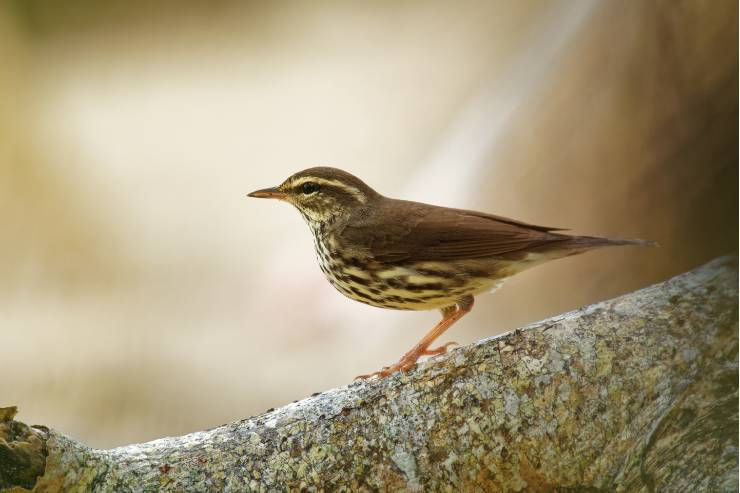
Size and wingspan of Northern Waterthrush:
- Length: 12–15 centimeters (4.7–5.9 inches)
- Wingspan: 21–24 centimeters (8.3–9.4 inches)
- Weight: 13 and 25 grams (0.46 and 0.88 oz)
Northern Waterthrushes are common in moist environments with dense ground cover.
It has an extensive geographic reach during the summer (Alaska to New Jersey) and winter (Florida to South America).
They use woody swamps, bogs, and thickets surrounding various wetlands throughout their extensive habitat.
They mostly eat larval and adult insects, as well as spiders, snails, salamanders, and fish. Stoneflies, mayflies, caddisflies, ants, and weevils are examples of some of the Northern Waterthrushes’ specific insect prey.
9. White-throated Sparrow (Zonotrichia Albicollis)
The white-throated sparrow is a passerine bird belonging to the Passerellidae family. It Is brown above and gray below, with an eye-catching head pattern.
The black-and-white-striped head is complemented by a white throat and yellow between the eye and the grey bill. The White-throated Sparrow can live up to six years.
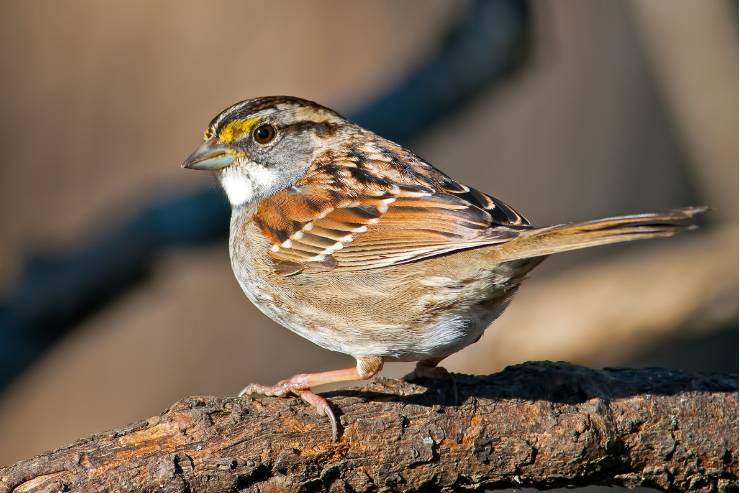
Size and wingspan of White-throated sparrow:
- Length: 15–19 centimeters (5.9-7.5 inches)
- Wingspan: 23 centimeters (9.1 inches)
- Weight: 22–32 grams (0.78-1.13 oz)
This species’ winter territory covers southern Nova Scotia to central Florida, northeastern Mexico, and Iowa, as well as the Great Plains and upper Midwest along major river valleys.
It lives in coniferous and mixed forests, primarily in dense thickets of deciduous shrubs, ponds, roadsides, clearings, edges, and secondary growth.
White-throated Sparrows primarily consume seeds and insects. They rely extensively on insects such as flies, ants, true bugs, beetles, wasps, millipedes, caterpillars, snails, and spiders.
Their winter diet consists primarily of weed and grass seeds. They also eat a lot of berries, particularly in the fall.
10. Grasshopper Sparrows (Ammodramus savannarum)
The grasshopper sparrow is a tiny and frequently neglected grassland bird.
The Florida Grasshopper Sparrow is a threatened species that can be found nowhere else.
The species has a short tail, a thick neck, and a flat head. It also has a cream-colored upper breast, a whitish lower breast, and a dark head separated by a pale Buffy-white crown stripe. It is a brown and tan bird.
These birds can survive for up to nine years.
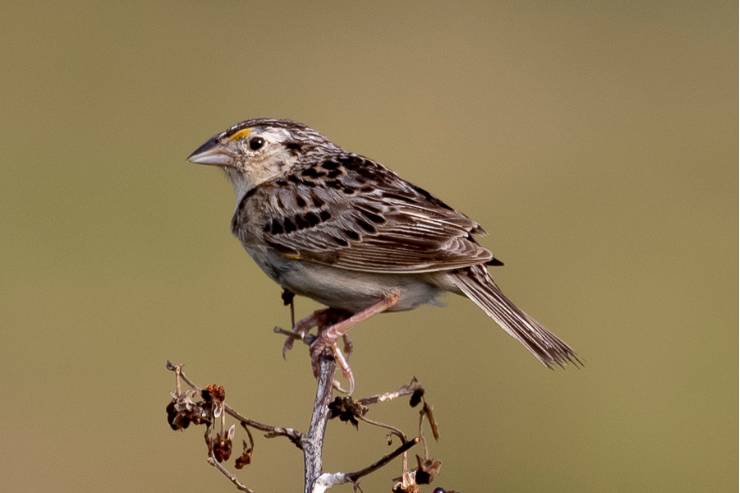
Size and wingspan of Grasshopper Sparrows:
- Length: 10.8-11.5 centimeters (4.3-4.5 inches)
- Wingspan: 20 centimeters (7.9 inches)
- Weight: 14–20 grams (0.5-0.7 oz)
They inhabit Polk, Osceola, Highlands, and Okeechobee in south-central Florida. Florida grasshopper sparrows prefer dry open plains with bunch grasses, low bushes, and saw palmetto.
It also prefers prairies, meadows, open pastures, and hayfields.
Grasshopper Sparrows feed on grasshoppers during the summer but consume caterpillars, bugs, spiders, and beetles. During the winter, they eat seeds.
11. House Wren (Troglodytes aedon)
The house wren belongs to the wren family Troglodytidae. It is a small bird with a short tail and a tiny bill.
The House Wren’s overall color is a muted brown with darker bars on the wings and tail.
House Wrens have a considerably fainter pale eyebrow than most other wren species. The longest known lifespan for a House Wren is seven years.
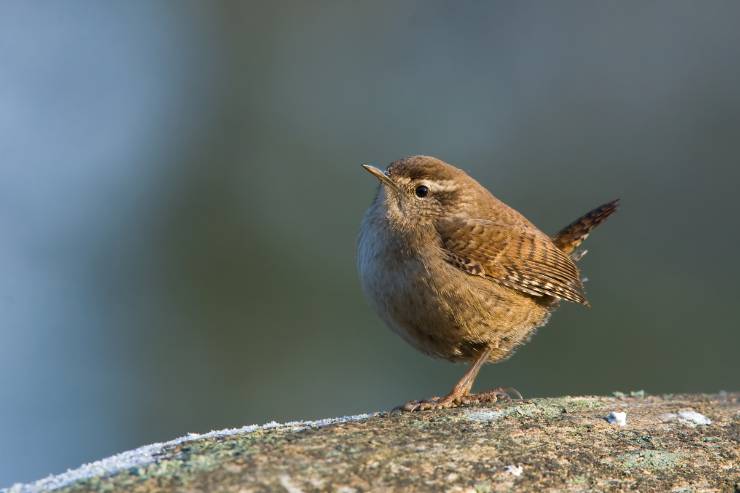
Size and wingspan of House Wren:
- Length: 11–13 centimeters (4.3-5.1 inches)
- Wingspan: 15 centimeters (5.9 inches)
- Weight: 10–12 grams (0.3-0.4 oz)
House Wren numbers have seen minor regional decreases, but overall populations have remained steady and somewhat risen.
They are winter visitors to Central Florida, often encountered from October to May.
In the summer, House Wrens like open forests, forest borders, and regions with scattered grass and trees. During the winter, they become more covert, favoring brushy tangles, thickets, and hedgerows.
House Wren prefer to eat insects. It eats many insects, including beetles, moths, crickets, flies, grasshoppers, caterpillars, and bugs.
12. Hermit Thrush (Catharus guttatus)
The hermit thrush is a medium-sized bird from North America. Its head and back are rich brown, and its tail is warm red.
The underparts are pale, with clear dots on the throat and smudged marks on the breast. With a close glance, you may discern a thin, light-eye ring but not a bold one.
This species lived at least eight years and eight months.
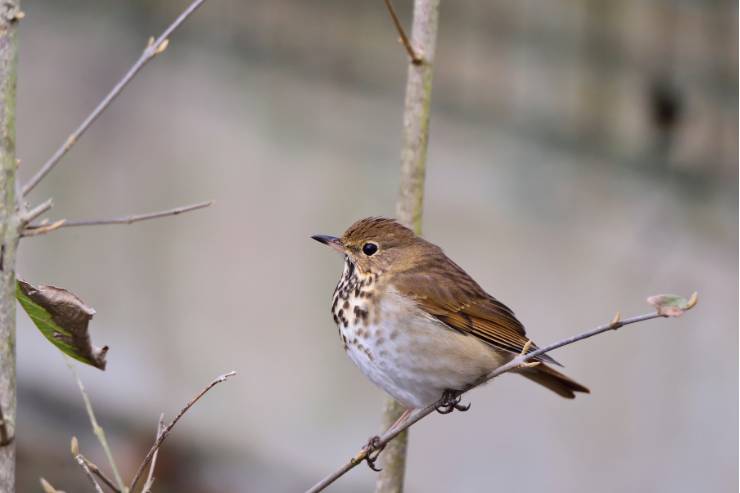
Size and wingspan of Hermit Thrush:
- Length: 4–18 centimeters (15.5-7.1 inches)
- Wingspan: 25–29 centimeters (9.8-11.4 inches)
- Weight: 23–37 grams (0.8-1.3 oz)
The Hermit Thrush is a resident of Florida. It is found in a wide range of woodland environments, but this species favors woodland interiors with openings, such as ponds or meadows nearby.
Hermit Thrush feeds on a wide range of insects, including beetles, ants, caterpillars, grasshoppers, crickets, earthworms, spiders, and, on rare occasions, small salamanders.
This bird also eats a lot of berries, especially in the winter; its diet includes pokeberries, elderberries, serviceberries, mistletoe berries, and grapes.
13. Brown-headed Nuthatch (Sitta pusilla)
The brown-headed nuthatch is a tiny songbird. This bird is white underneath and gray above, with a brown head.
It has a white mark on the back of its head and small white spots on its tail that may be seen in flight.
Males and females appear similar. The longest known longevity for a brown-headed nuthatch was nine years.
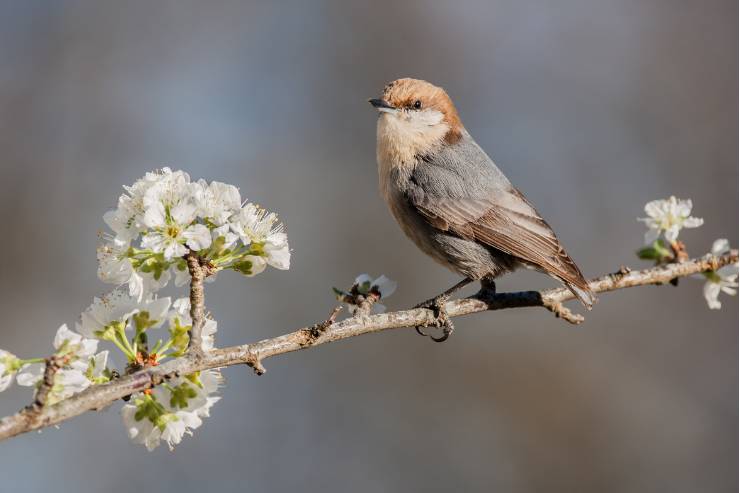
Size and wingspan of Brown-headed Nuthatch:
- Length: 10–11 centimeters (3.9-4.3 inches)
- Wingspan: 16–18 centimeters (6.3-7.1 inches)
- Weight: 10 grams (0.3 oz)
They live in Southeastern pine woods filled with loblolly, long and short leaf, and slash pine trees. They are also found in open, mature pine forests rather than mixed pine-hardwood areas.
Brown-headed nuthatches are in danger due to the degradation of their pine forest habitats.
They eat both insects and pine seeds. Brown-headed nuthatches are rare birds that use tools to find food.
| Fact: These species carry a loose piece of bark in their beak and utilize it to poke up other pieces of bark to look for insects for their diet. |
14. Willet (Tringa semipalmata)
Willets are big shorebirds belonging to the Scolopacidae family. They are quite large and powerful sandpipers and the largest species of “shanks” in the Tringa genus.
They have long legs and thick, straight bills that are longer than their head.
Their wings are wider and rounder than those of many other shorebirds, and their tails are short and square at the base. Willets can live for ten years.
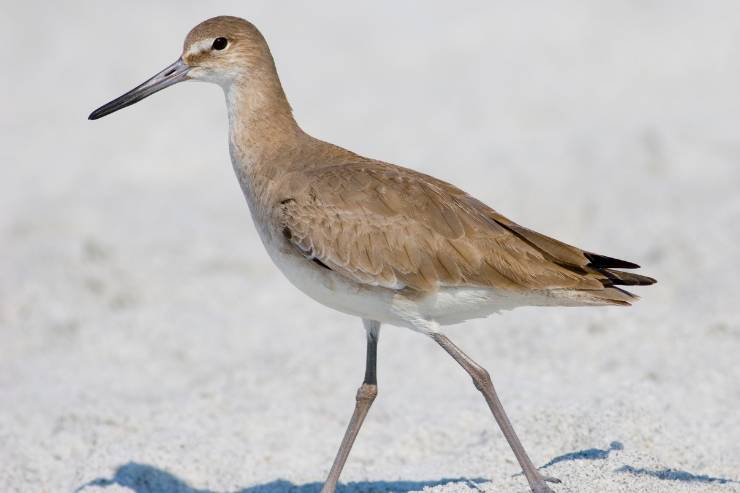
Size and wingspan of Willet:
- Length: 33–41 centimeters (13.0-16.1 inches)
- Wingspan: 70 centimeters (27.6 inches)
- Weight: 200–330 grams (7.0-11.6 oz)
Willets are shorebirds that can be spotted throughout the year on Florida’s beaches, salt marshes, and mud flats.
Its diet varies per location. Willets primarily eat aquatic insects in inland waters.
They also eat a variety of crabs along the coast, especially fiddler crabs.
Similarly, they eat other crustaceans, small mollusks. It occasionally has small fish and plant material like grass, seeds, and young shoots
15. Swainson’s Thrush (Catharus ustulatus)
Swainson’s thrush is a medium-sized thrush, commonly known as olive-backed thrush or russet-backed thrush.
They have olive-brown to rust-brown upper portions and a cream-colored underbelly with pale brown patches that appear on the breast but are smudgier further down on the belly.
Swainson’s thrushes can live for up to 11 years or more in the wild, but they usually live only one to two years.
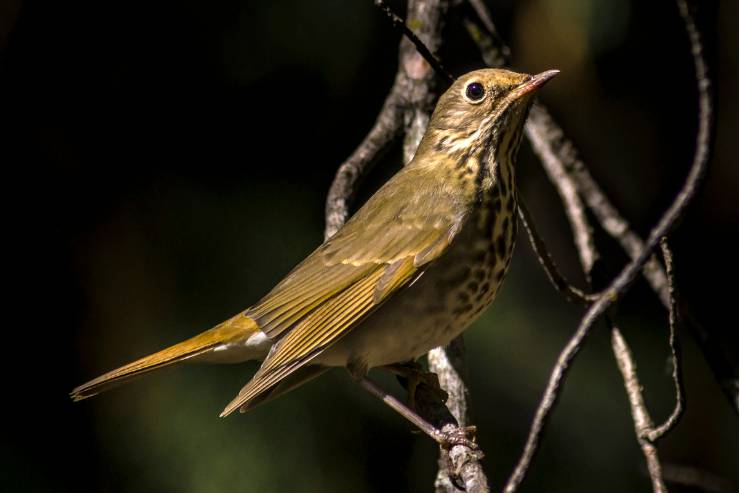
Size and wingspan of Swainson’s Thrush:
- Length: 16–19 centimeters (6.3-7.5 inches)
- Wingspan: 29–31 centimeters (11.4-12.2 inches)
- Weight: 23–45 grams (0.8-1.6 oz)
Swainson’s thrushes are regular travellers in South Florida. They reside in dense, thick forests containing leafy trees and conifers.
It likes to be in locations with plenty of undergrowth. While traveling, they are frequently seen in woodlands, lake borders, and suburban parks.
Swainson’s thrushes eat primarily insects. However, they will include additional fruits and berries in their diets during the fall and winter.
Conclusion
Brown birds are integral to Florida’s ecosystems, enhancing the state’s avian diversity from woodlands to wetlands. Species like the Brown Thrasher, Swamp Sparrow, and Carolina Wren contribute unique traits to their habitats.
These birds enrich Florida’s landscapes, from the Brown Pelican’s coastal majesty to the Grasshopper Sparrow’s subtle beauty.
Beyond aesthetics, they play vital roles in controlling insects, dispersing seeds, and indicating environmental health.
Protecting their habitats is crucial for preserving biodiversity. By appreciating and conserving these habitats, we ensure a brighter future for brown birds and their ecosystems.
Let us enjoy Florida’s brown birds, recognize their importance, and work to protect their habitats for future generations.






